Updated February 2024.
SEO vs PPC – which is better for driving more traffic to your website?
Although both methodologies aim to boost website traffic and increase visibility on search engines, they operate in distinctly different ways and offer unique advantages. So understanding the nuances of these two powerful tools is essential for any business looking to create a balanced, efficient and cost-effective online marketing strategy.
Whether you’re a small business owner, a digital marketing novice or a seasoned professional, finding the right balance between SEO and PPC is pivotal in shaping your online presence and driving your business’s growth.
In this guide, we’ll look at the long-term value of SEO, the immediate impact of PPC, and how a strategic integration of both can lead to unparalleled success.
TABLE OF CONTENTS:
Their expertise has helped Nextiva grow its brand and overall business
Introduction to SEO vs PPC
In digital marketing, two strategies frequently dominate the conversation: Search Engine Optimization and Pay-Per-Click advertising. Both play crucial but different roles that are vital for any successful digital marketing strategy. Let’s take a quick look at what is PPC and SEO.
What Is SEO?
Search Engine Optimization is the process of optimizing a website to enhance its visibility in the organic search results of search engines like Google. SEO techniques include various elements such as keyword research, content creation, website optimization, and building backlinks.
The aim is to attract organic traffic by ranking high for search queries relevant to the business or content topic. Something we’re experts at.
In this playbook, we’ll cover
1. SEO strategy in a nutshell
2. All SEO tools you need
3. Programmatic SEO and utilizing AI
Let’s dive in 👇
— ericosiu (@ericosiu) September 14, 2023
What Is PPC?
Pay-Per-Click advertising is a model of internet marketing where advertisers pay a fee each time one of their ads is clicked. It’s essentially a way of buying visits to your site, rather than attempting to “earn” those visits organically, as with SEO.
Platforms like Google Ads and Microsoft Ads (formerly Bing Ads) are popular for PPC campaigns, offering targeted advertising based on user queries, demographics, and other data.
SEO vs PPC in Marketing
SEO and PPC serve different yet complementary roles in digital marketing:
- SEO: This strategy is about building a long-term foundation for online presence. Effective SEO leads to higher rankings, which can result in consistent traffic and increased credibility without the ongoing costs associated with PPC.
- PPC: This strategy offers immediate visibility and quick results. PPC is particularly effective for specific campaigns, like product launches or seasonal promotions, and provides valuable data on keywords and user behavior.
Balancing PPC and SEO is crucial for several reasons:
- Comprehensive Visibility: Using both strategies can cover different stages of the buyer’s journey, from awareness (often through SEO) to decision-making (aided by targeted PPC ads).
- Data Integration: Insights from PPC can inform SEO strategies (and vice versa), leading to more refined targeting and optimization.
- Budget Efficiency: Balancing both helps allocate marketing budgets more effectively, investing in long-term growth (SEO) while capitalizing on immediate opportunities (PPC).
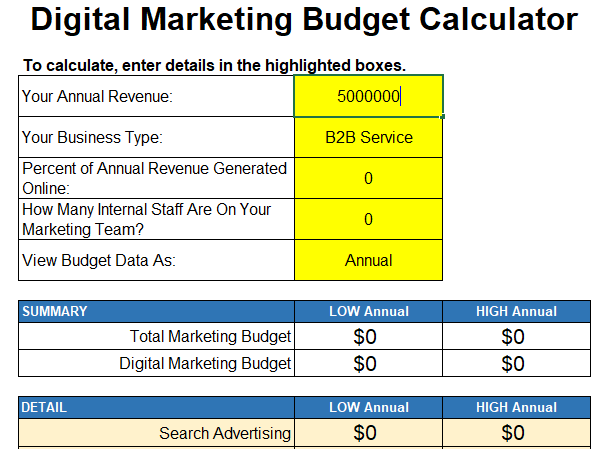
So, while SEO builds a strong, organic foundation, PPC provides quick, targeted visibility. Understanding how to leverage both ensures that a business can not only attract but also effectively engage and convert its target audience.
Advantages and Limitations of SEO
Search Engine Optimization is a cornerstone of digital marketing strategy, known for its ability to organically elevate a website’s visibility in search engine results. It involves optimizing various elements of a website — from content quality and keyword relevance to site architecture and user experience — to rank higher in the SERPs.
Advantages of SEO:
- Long-Term Traffic Growth: SEO efforts compound over time, often resulting in sustained traffic growth. Unlike paid advertising, the benefits of a well-executed SEO strategy can continue long after the initial work is done.
- Cost-Effectiveness: Although SEO requires an initial investment, especially if outsourcing to experts, it’s generally more cost-effective in the long run compared to ongoing PPC campaign costs.
- Credibility and Trust: Websites that rank high in organic search results are often viewed as more credible and trustworthy by users, as they are perceived to have earned their position.
- Better User Experience: SEO encourages the enhancement of website usability. A well-optimized site typically offers a better user experience, which can lead to higher conversion rates and customer retention.
Limitations of SEO:
- Time-Consuming: One of the primary drawbacks of SEO is that it takes time to see results. Depending on the competitiveness of the industry, it can take months to climb SERPs rankings.
- Constantly Evolving Algorithms: Search engines frequently update their algorithms, meaning SEO strategies need to be dynamic and adaptive. This requires continuous learning and strategy adjustment.
- No Guaranteed Results: Despite best efforts, high rankings cannot be guaranteed due to the unpredictability of search engine algorithms and the competitive nature of the digital space.
- Vulnerability to Search Engine Changes: A website’s traffic can be significantly impacted by changes in search engine policies and algorithms, leading to potential volatility in organic reach.
Single Grain SEO Case Study
Single Grain was tasked with improving blog performance for an e-commerce wine retailer. Wine Deals wanted to focus on improving blog performance by focusing on articles with low click through rates.
Using GSC data, our team identified blogs with low CTR. We then used AI-assisted content optimizations and specifically tailored client prompts to build out SEO-optimized content on 23 identified low-performance pages.
Within six months the client saw:
- +268% increase in clicks
- +11.7% increase in average position improvement
- +0.6% increase in CTR
Advantages and Limitations of PPC
Pay-Per-Click advertising is a dynamic component of digital marketing that offers unique advantages for businesses looking for immediate impact and targeted reach. However, like any strategy, it comes with its own set of limitations. Understanding both sides is important if you want to effectively use PPC in your marketing mix.
Advantages of PPC:
- Immediate Results: Unlike SEO, which builds over time, PPC can drive traffic to your website almost immediately after campaign launch. This makes it ideal for short-term goals or time-sensitive promotions.
- Precise Targeting: PPC platforms offer advanced targeting options, including demographics, location, interests, and even specific times of day. This enables businesses to reach their ideal audience more effectively.
- Measurable ROI: With PPC, every aspect of the campaign is measurable, from the number of clicks to conversions. This data-driven approach allows for precise calculation of ROI and aids in making informed budgeting decisions.
- Flexibility: PPC campaigns can be adjusted quickly based on performance data. This level of control allows businesses to respond rapidly to market changes or new trends.
Limitations of PPC:
- Costs Can Escalate: The pay-per-click model means costs can add up quickly, especially in competitive industries. Without proper management, PPC can become expensive with lower returns.
- Short-lived Without Continuous Investment: The visibility PPC offers is only present as long as you pay for it. Once the campaign ends, the traffic generated through PPC typically stops as well.
- Requires Expertise and Time: Effective PPC campaigns require expertise in campaign setup, management, and optimization. This can be time-consuming and often requires professional help.
- Ad Blindness: Some users have become accustomed to ignoring ads, a phenomenon known as ‘ad blindness’ or ‘ad fatigue‘. This can reduce the effectiveness of PPC campaigns, especially if they are not well-targeted or creatively designed.
Single Grain Paid Media Case Study
This case study is of a client that is an AI-powered workplace communications platform. They reached out to Single Grain to launch a paid social and search strategy for their digital marketing campaign. The client had no existing digital ads and low brand awareness.
We created a comprehensive paid strategy for search engines. We also used LinkedIn to establish our client as a leader in their niche to increase organic traffic.
In only three months after paid search and LinkedIn campaign launch, the client achieved a 24% increase in conversions. We achieved these results while reducing costs by 16% and maintaining a CPA of -32%.
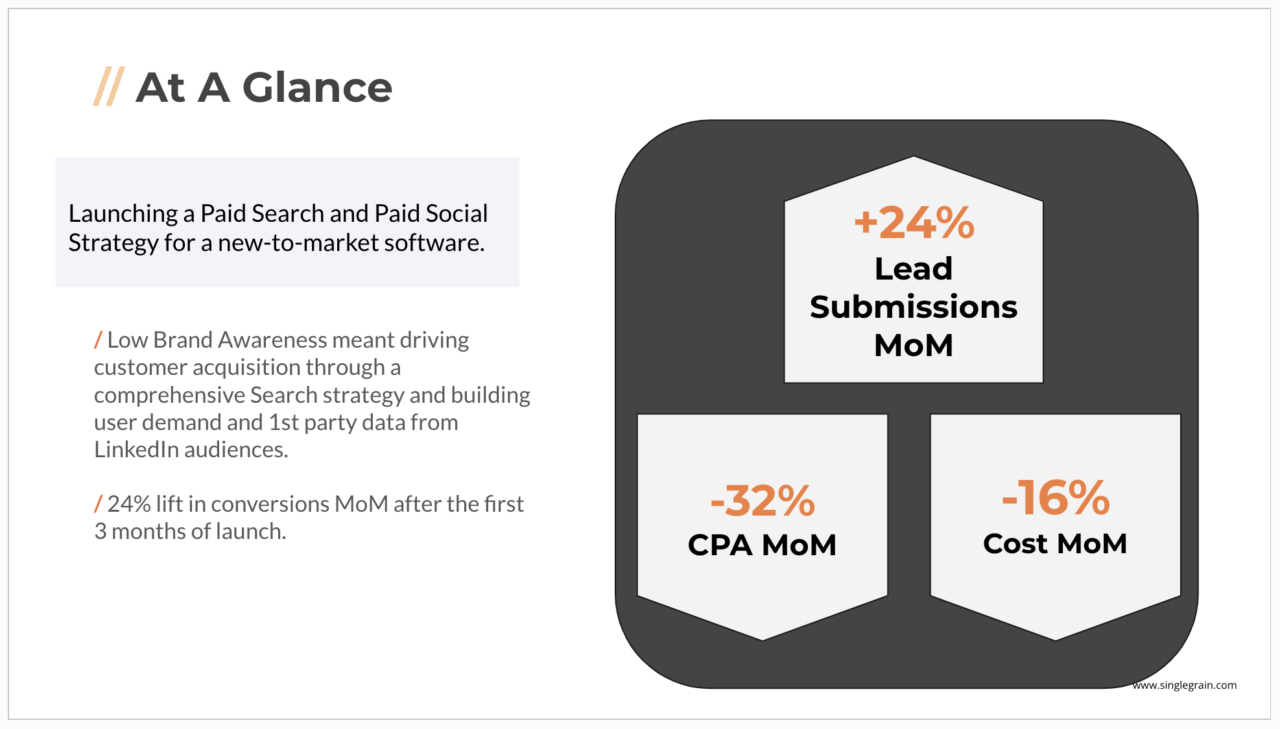
Just want someone to do all this work for you? Single Grain’s SEO & PPC experts can help!👇
Strategic Integration of SEO and PPC
SEO and PPC are often viewed as separate strategies, but when integrated effectively, they can enhance overall marketing performance.
Let’s use a fictional company, GreenGlow Skincare, an emerging brand in the eco-friendly beauty industry, to illustrate how businesses can leverage both PPC and SEO for maximum benefit.
Data Sharing for Improved Insights
Use data from PPC campaigns to inform your SEO strategy. PPC provides immediate feedback on keyword effectiveness, which can be invaluable for SEO keyword optimization.
Example: GreenGlow uses PPC data – primarily through the analytics and reporting features of the PPC platforms they use, such as Google Ads or Bing Ads – to identify high-performing keywords for their organic sunscreen line. They analyze metrics like click-through rates (CTR), conversion rates, and cost per conversion to identify which keywords are most effective in their PPC campaigns.
Then they optimize their website’s content with these keywords to improve organic rankings.
Enhanced Visibility Across Search Engine Results
Running both SEO and PPC campaigns simultaneously can dominate the search engine results pages. This dual presence reinforces brand visibility and can increase overall traffic.
Example: By running PPC and SEO campaigns simultaneously, GreenGlow appeared both in the top ad spots and organic listings for searches like “organic skincare” and “eco-friendly beauty products,” boosting brand awareness.
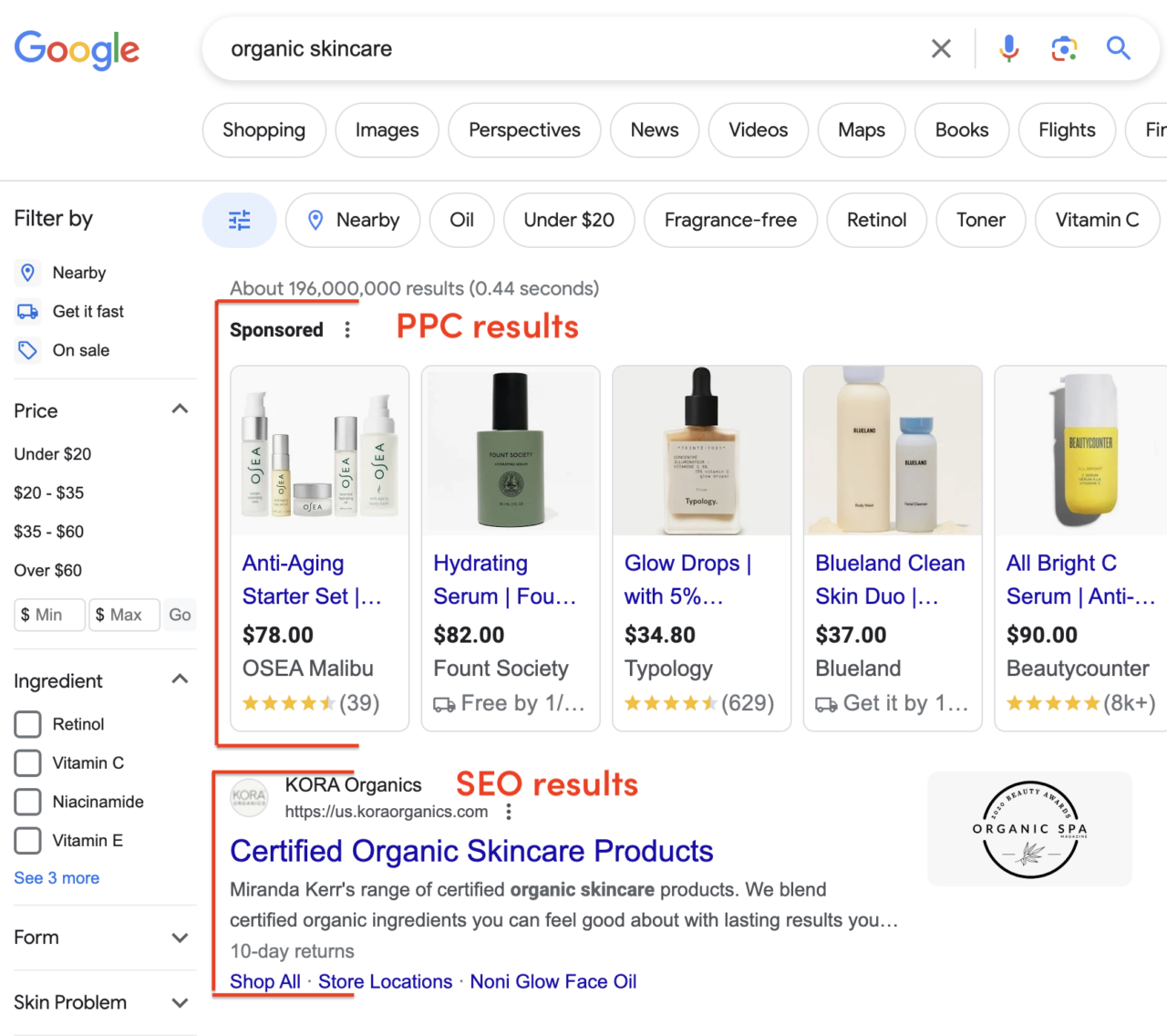
Using PPC to Test SEO Strategies
PPC is an excellent tool for testing the effectiveness of different keywords, ad copy, and strategies before implementing them in long-term SEO practices.
Example: GreenGlow tested ad copy variations for their new anti-aging cream in PPC ads, and the most engaging messages were then used to update website content and metadata for SEO.
Their strategy might look something like this:
- Initial PPC Ad Copy Testing: GreenGlow creates several variations of PPC advertisements for their new anti-aging cream. Each ad variation features different headlines and descriptions. For example, one ad might emphasize “Natural Anti-Aging Formula,” while another focused on “Visible Results in 2 Weeks.”
- Monitoring Ad Performance: Over a set period, they closely monitor the performance of each ad variation using metrics like click-through rate (CTR), conversion rate, and engagement. They also track which ad messages led to longer website visits and higher purchase rates.
- Identifying Winning Messages: Let’s say the ad emphasizing “Visible Results in 2 Weeks” has the highest CTR and conversion rate. This indicates that customers are particularly interested in quick results from their anti-aging products.
- Applying Insights to SEO: Armed with this information, GreenGlow updates their website’s content for the anti-aging cream. They include phrases like “fast-acting” and “visible results in weeks” in the product description, blog posts, and meta tags. They also create an FAQ section answering common questions related to the product’s effectiveness and time frame.
- SEO Content Optimization: In addition to incorporating the successful ad copy phrases, GreenGlow optimizes their website content by adding customer testimonials that mention quick results and by creating blog posts about the science behind their fast-acting ingredients.
- Metadata and Alt Text Updates: They also revise meta descriptions for the product pages and blog posts to include phrases like “quick results” and “effective anti-aging.” Plus, they make sure that images related to the anti-aging cream have alt text reflecting these phrases for improved SEO.
Balancing Short-Term and Long-Term Objectives
While SEO builds a foundation for organic traffic in the long run, PPC can provide immediate results and cover gaps during the SEO ramp-up period.
Example: While building their SEO presence, GreenGlow uses PPC to drive immediate traffic to their seasonal sale page, ensuring consistent online visibility. Here’s what they objectives might look like:
Short-Term Objective (Using PPC):
- Objective: Drive immediate traffic to GreenGlow’s seasonal sale page featuring their eco-friendly skincare products.
- Strategy: Implement a targeted PPC campaign that focuses on high-intent keywords related to the sale, like “eco-friendly skincare discounts” or “organic beauty product sale.” The ads would directly link to the seasonal sale page.
- Outcome Expected: Increase in website traffic, higher engagement on the sale page, and a boost in sales during the promotional period. The aim is to capitalize on the immediate visibility and targeting capabilities of PPC to attract customers looking for deals and promotions.
Long-Term Objective (Using SEO):
- Objective: Establish GreenGlow as an authority in the eco-friendly skincare industry and consistently rank high for broad and niche organic skincare related keywords.
- Strategy: Develop a comprehensive SEO strategy that includes creating informative blog content about eco-friendly skincare, optimizing product pages for organic search, building backlinks from reputable beauty and health websites, and ensuring the website offers an excellent user experience.
- Outcome Expected: Gradual increase in organic search rankings, leading to sustained organic traffic growth, enhanced brand credibility, and customer loyalty. The focus is on building a strong, lasting online presence that continually attracts and engages customers interested in eco-friendly skincare.
Holistic View of Customer Journey
Integrating SEO and PPC strategies gives a more comprehensive view of the customer journey, allowing for more effective targeting and personalization at different stages of the buying process.
Example: By merging SEO and PPC data, GreenGlow identifies customer preferences and purchase patterns, enabling them to tailor content across both channels for each stage of the customer journey, such as:
Awareness Stage:
- SEO: Blog posts on topics like “Benefits of Eco-Friendly Skincare” or “Why Organic Ingredients Matter.”
- PPC: Display ads targeting skincare enthusiasts with messages like “Discover Eco-Friendly Beauty” linking to educational content.
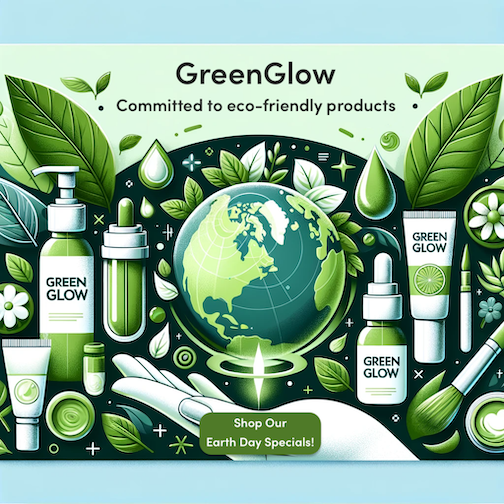
Interest Stage:
- SEO: Detailed product descriptions and benefits, including customer reviews and testimonials.
- PPC: Search ads with keywords like “natural anti-aging cream” leading to specific product pages.
Consideration Stage:
- SEO: Comparison articles and videos between GreenGlow products and other market options.
- PPC: Remarketing ads showcasing product benefits and special offers for visitors who engaged with previous content.
Intent Stage:
- SEO: Optimized landing pages for high-intent keywords, such as “buy organic sunscreen.”
- PPC: Shopping ads and search ads with strong call-to-actions, like “Shop Now” for products in their cart or viewed items.
Purchase Stage:
- SEO: Easy navigation and clear calls-to-action on the website to facilitate the purchase process.
- PPC: Use of Google Shopping ads to directly promote products and special discount codes.
Post-Purchase Stage:
- SEO: Follow-up content such as “How to Use Our Skincare Products Effectively” or “Skincare Tips and Tricks.”
- PPC: Remarketing ads or email campaigns targeting existing customers with offers on complementary products or refill discounts.
Advocacy Stage:
- SEO: Encouraging user-generated content, such as customer reviews and social media mentions.
- PPC: Campaigns highlighting customer stories and testimonials to build brand loyalty and encourage referrals.
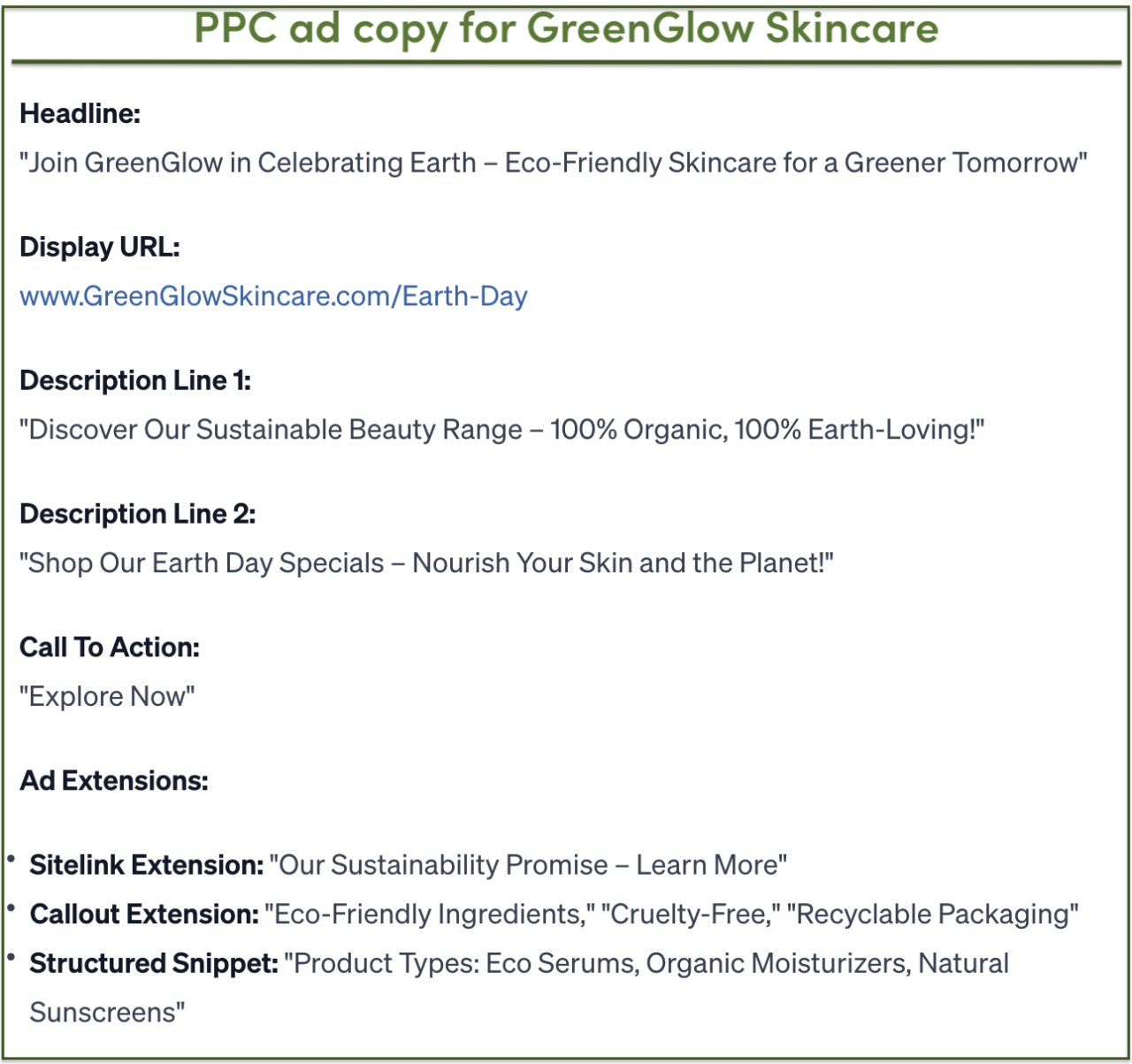
Optimizing for High-Conversion Keywords
Use the insights gained from PPC conversion data to focus SEO efforts on the most lucrative keywords, optimizing for both traffic and conversions.
Example: Analyzing PPC conversion data, GreenGlow focused their SEO efforts on terms like “natural acne treatment,” which had high conversion rates in PPC campaigns.
Combating Negative PR
PPC can be a quick tool to manage your online reputation. Use PPC ads to counteract negative publicity or misinformation, while building a positive SEO presence with quality content.
Example: When faced with misinformation about an ingredient, GreenGlow used targeted PPC ads to direct traffic to educational content on their site, while enhancing their SEO strategy with positive, informative articles.
Seasonal and Promotional Opportunities
Use PPC for short-term campaigns around holiday events, sales or promotions while maintaining a consistent SEO strategy for year-round visibility:

Example: For their Earth Day campaign, GreenGlow launched a PPC campaign highlighting their commitment to sustainability, while their SEO efforts continued to promote their year-round eco-friendly ethos.
By strategically integrating SEO and PPC, businesses can not only enhance their online presence but also create a more resilient and adaptable marketing strategy.
SEO vs PPC: Determining the Right Mix for Your Business
Finding the optimal balance between SEO vs paid search is critical for digital marketing success. This balance varies for different businesses, depending on various factors.
Here’s how businesses like GreenGlow Skincare can determine the right mix for them in order to reap the SEO and PPC benefits.
Understanding Business Objectives and Market Dynamics:
- Short-term vs. Long-term Goals: Align strategies with business goals. Use PPC for quick results like product launches and SEO for long-term brand building.
- Industry and Competition Analysis: Analyze the competitive landscape. Highly competitive markets might benefit more from aggressive PPC strategies.
Budget Considerations:
- Resource Allocation: Evaluate the budget for both immediate (PPC) and sustained (SEO) investments. Balance spending based on available resources and ROI.
- Cost-Effectiveness: Continuously assess the cost-effectiveness of both strategies. Adjust allocation to favor the most profitable approach.
Target Audience Insights:
- Customer Behavior: Understand where your audience spends their time online and how they search for products or services.
- Segmentation and Targeting: Use SEO for broader audience reach and PPC for targeting specific segments.
Performance Measurement and Analytics:
- KPI Tracking: Track key performance indicators (KPIs) like click-through rates, conversion rates, and organic traffic.
- Analytics Tools: Use analytics tools like Google Analytics and Google Search Console to measure the success of SEO and PPC strategies, understanding which channels drive the most valuable traffic.
Flexibility and Adaptability:
- Test and Learn: Continuously test different approaches in both SEO and PPC, learning from analytics and market feedback.
- Adaptation to Market Changes: Be prepared to adapt strategies in response to search engine algorithm updates, market trends, and consumer behavior shifts.
Conclusion: Harmonizing SEO vs PPC for Optimal Results
SEO or PPC? Well, it’s not about choosing one over the other, but rather understanding how to harmonize these two strategies for the best outcomes.
SEO is a marathon, not a sprint. It builds a solid foundation for your online presence, bringing long-term benefits through organic search traffic. PPC offers the agility and precision needed for immediate results and specific campaign goals.
Think about SEO and PPC marketing as two sides of the same coin, each with unique strengths. When used together, they create a comprehensive digital marketing strategy that can adapt to changes, meet customer needs, and achieve business goals.
If you’re ready to level up your business with both organic and paid efforts, Single Grain’s SEO & PPC experts can help!👇
SEO vs PPC FAQs
-
Which is better, SEO or PPC?
Neither SEO nor PPC is universally “better” than the other. The choice depends on your business goals, budget, and timeline. SEO is ideal for long-term organic growth and building credibility, while PPC is effective for immediate results and targeting specific audiences. A balanced approach often yields the best results.
-
Is SEO or PPC more expensive?
The costs depend on various factors. Initially, PPC might seem more expensive due to its pay-per-click model. However, SEO also requires a significant investment in time and resources to create content, optimize websites, and build backlinks. Long-term, SEO can be more cost-effective as it delivers sustained organic traffic.
-
What is the difference between an SEO and a PPC agency?
An SEO agency specializes in optimizing websites to rank higher in organic search results, focusing on content creation, keyword optimization, link building, and improving site structure.
A PPC agency, on the other hand, specializes in managing pay-per-click advertising campaigns, focusing on ad creation, bid management, and optimizing for conversions and ROI. Some agencies offer both services.
-
Does PPC improve SEO?
Directly, PPC does not improve SEO rankings as search engines keep ad and organic search results separate. However, PPC can indirectly benefit SEO by increasing brand exposure, which might lead to more organic searches and potentially more backlinks. Insights from PPC campaigns can also inform SEO keyword strategies.


